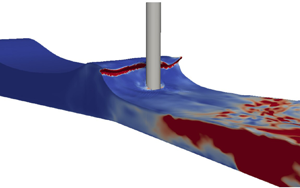Article contents
On the turbulence modelling of waves breaking on a vertical pile
Published online by Cambridge University Press: 02 December 2022
Abstract

Incipient wave breaking on a vertical circular pile is simulated with a Reynolds stress– $\omega$ turbulence model. Comparison of results simulated with a stabilized two-equation turbulence model, as well as no turbulence model, demonstrates that the breaking point and the peak force on a vertical cylinder due to incipient breaking should not be affected by the turbulence closure model, provided that it is stable and the simulations are converged. Notably, the present results show that the build-up to peak force induced by incipient wave breaking can be accurately predicted without any turbulence closure model. However, for the prediction of the secondary load cycle (SLC), proper turbulence modelling is required, as this process involves both turbulence production and lee-side flow separation. The Reynolds stress–
$\omega$ turbulence model. Comparison of results simulated with a stabilized two-equation turbulence model, as well as no turbulence model, demonstrates that the breaking point and the peak force on a vertical cylinder due to incipient breaking should not be affected by the turbulence closure model, provided that it is stable and the simulations are converged. Notably, the present results show that the build-up to peak force induced by incipient wave breaking can be accurately predicted without any turbulence closure model. However, for the prediction of the secondary load cycle (SLC), proper turbulence modelling is required, as this process involves both turbulence production and lee-side flow separation. The Reynolds stress– $\omega$ model is demonstrated to predict the SLC more accurately than a stabilized two-equation
$\omega$ model is demonstrated to predict the SLC more accurately than a stabilized two-equation  $k$–
$k$– $\omega$ turbulence model, as the flow separation points and vorticity field are better predicted. Some existing studies indicate that the generation of the SLC does not necessarily result from flow separation, but is rather due to the suction force. The present work finds that the occurrence and point of flow separation significantly affect the magnitude of the suction force, which hence affects the SLC prediction significantly. For waves breaking on a vertical pile, proper turbulence modelling is therefore essential for accurate SLC predictions. (In the above,
$\omega$ turbulence model, as the flow separation points and vorticity field are better predicted. Some existing studies indicate that the generation of the SLC does not necessarily result from flow separation, but is rather due to the suction force. The present work finds that the occurrence and point of flow separation significantly affect the magnitude of the suction force, which hence affects the SLC prediction significantly. For waves breaking on a vertical pile, proper turbulence modelling is therefore essential for accurate SLC predictions. (In the above,  $k$ is the turbulent kinetic energy density and
$k$ is the turbulent kinetic energy density and  $\omega$ is the specific dissipation rate.)
$\omega$ is the specific dissipation rate.)
JFM classification
- Type
- JFM Papers
- Information
- Copyright
- © The Author(s), 2022. Published by Cambridge University Press
References
REFERENCES
- 6
- Cited by





